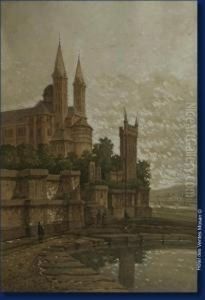Franz Stoobant Paintings
Franz Stroobant was a Belgian artist born in 1819 in Brussels and passed away in 1916. He was a versatile figure in the 19th-century art world, known primarily for his work as a lithographer, painter, and illustrator. Stroobant's artistic journey began at a young age, showing an early interest in the arts. His education and training in art took place in Belgium, where he was deeply influenced by the rich cultural and artistic heritage of his homeland.
Throughout his career, Franz Stroobant was particularly renowned for his lithographic works. Lithography, a printing process that allows for the creation of images or text with oil or fat and gum arabic on a smooth limestone or metal surface, was a popular medium in the 19th century for reproducing images. Stroobant excelled in this technique, producing detailed and high-quality prints that captured the attention of both the public and his peers. His contributions to lithography were significant during a time when the demand for printed images was growing, thanks to advancements in printing technology and the increasing interest in visual culture among the European middle class.
In addition to lithography, Stroobant showed remarkable skill as a painter and illustrator. His subjects varied widely, from architectural views, which were highly popular among tourists and collectors of the time, to historical scenes and landscapes. Stroobant's ability to capture the essence of his subjects with accuracy and a keen eye for detail made his works sought after. He was particularly adept at architectural painting, a genre that required precision and a deep understanding of perspective and structure. His illustrations often accompanied texts, providing visual narratives that enhanced the written word.
Franz Stroobant's contribution to the art world of the 19th century goes beyond his creations. Through his works, he played a part in the dissemination of visual culture, contributing to the historical record of landscapes and architectural heritage, some of which have since changed or no longer exist. His legacy is preserved in the collections of various museums and in the pages of 19th-century publications, where his prints and illustrations continue to be appreciated for their historical value and artistic quality. Stroobant's career reflects the vibrant and evolving art scene of his time, marking him as a significant figure in the transition from traditional to modern artistic expressions.
